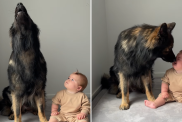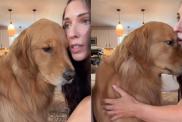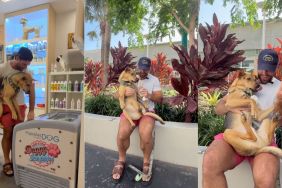The “Stay” request is different from “Settle Down.” Whereas “Settle Down” means wait quietly in the designated spot but in any body position that is comfortable, “Stay” means remain in place and in the specific body position requested. Both “Settle Down” and the various “Stay” commands have many useful applications. “Settle Down” or “Wait” is generally used for longer periods of time at home, on picnics, in the car or in the veterinarian’s waiting room. “Stay” is used for shorter periods. “Sit-stay” is useful when opening the front door, when getting out of your car, when greeting people. “Down-stay” is effective for controlling your dog around rambunctious children or fearful and aggressive dogs. “Stand-stay” and “Bang” (see Tricks) are essential when grooming the dog or during physical examinations in the veterinary clinic.
A good “Settle Down” command is the foundation for teaching specific stays. Once the pup has learned to stay put in a specific location, it is easier to teach it to stay in a specific body position. Also, when teaching the inhibitory “Off” command, you may already have discovered your pup voluntarily settled down or performed quite respectable stand-stays, sit-stays and down-stays of its own accord. Similarly, some family members have already enticed the pup to perform fairly lengthy and solid stays during the stay-delay exercise. The success of teaching “Stay” depends upon: 1) starting with very short stays, so your puppy may succeed from the outset and 2) frequently rewarding your pup while it remains in the appropriate position.
How to teach the ‘stay’ command
To teach stays, simply increase the length of time of the Stay-Delays discussed earlier. Start off with extremely short stays, so your pup may succeed and be rewarded for succeeding. Increase the length of the stays only very gradually. Do not push your pup to the point of failure. You will get frustrated, and your pup will probably be punished. This is not fair for either of you. Training is meant to be an enjoyable learning experience. Sadly though, some people do just about everything wrong when teaching stays. They command the puppy as if it were in boot camp, force it into position, stare at it menacingly whilst it remains in position, offering not a single word of thanks as they proceed to push the pup to the very precipice of failure, and then, when eventually and predictably, the poor puppy breaks its stay, it is reprimanded and physically forced back into position. For goodness sakes, if you’re eager to punish something, go and punish a rock. But if you want to teach your dog to stay, let’s do it in a fair and proper fashion.
Although your pup does not appear to be doing much when it stays, it is in fact inhibiting its movement for a long period of time, which is an utterly tremendous achievement for any young puppy. As such, your pup deserves a whole lot of praise and/or rewards for its effort. Although an inhibitory command for the dog, initial stay-training should be an active teaching process for the owner. In order to receive absolute attention from your pup, you must devote absolute attention towards the pup. To teach stays quickly, your pup requires complete surveillance and continual feedback – “Good Sit-Stay, Rover,” conveying four bits of information: 1) praise, 2) the pup’s name, 3) the specific body position and 4) the concept command – stay.
1) “Good Dog” – Periodic praise informs your pup so far so good. During initial training especially, it is important to regularly praise and reward the pup for getting it right. Consider, for example, a dog which breaks a stay after only 15 seconds. If you observed your dog’s stay in silence, only to reprimand it for breaking, your dog will learn staying is a drag, because it is punished after 15 seconds of stay. If, however, you praise your dog every three seconds: at least 12 seconds of stay have been rewarded before gently reprimanding the dog for breaking the stay. Thus, your dog will learn that staying is good and breaking the stay is bad. Now, we’re getting somewhere.
On their own, punishments are counterproductive – tending to de-stabilize stays and erode the dog’s trust in the owner. On the other hand, each reward reinforces the specific stay position, as well as building the dog’s confidence to accept and learn from occasional instructive reprimands.
Of course, with a young puppy, until it understands the meaning and the relevance of staying, it will not be reprimanded at all. Instead, just request the pup to sit again, and perform a couple of shorter stays (say six seconds and eight seconds) in an easier body position. Praise the pup all the time it stays, and reward it with a treat once it completes the short stays successfully. Then, try for a longer 15-second stay once more.
2) “Rover” – Using the puppy’s name as a prefix for all puppy commands informs the pup the instruction was intended for Rover, not Fido and not Jamie. The pup has a name, and so let’s use it: “Rover, Sit,” “Rover, Down,” “Rover, Sit-Stay,” “Good Dog, Rover,” “Good Sit-Stay Rover.”
3) “Sit” – When teaching three or more stay positions, it is vital to repeat the specific position command, in this case, “Sit.” Otherwise your pup may get confused. Breaking position but remaining in place or running to the owner, are both signs of a confused puppy which is still trying to please its owner. Similarly, breaking stays to run off to play with other dogs is also a sure-fire sign of a confused puppy, even though it is trying to please itself. Both of these confused puppies are insufficiently trained. Back to square one. Later in training, “Sit!” will be used as an instructive reprimand to counteract for broken stays.
4) “Stay” – Nearly everybody says the word “Stay,” so enough said. Only, don’t shout, and don’t threaten. There is no need to command the pup, just politely request it to “Sit-stay” in a kind and reassuring voice. A well-trained dog willingly obeys whisper-requests. Of course, just because we ask the dog nicely does not mean to say it has the option of not complying. Once trained, if the dog breaks a stay, it will be reprimanded.
During stays, it is advisable to insist your puppy pay attention and watch you. However, if you do not pay attention, neither will your dog. And if your dog’s attention is allowed to wander, so will your dog wander. Early stay-training is an active, exacting and exhausting endeavor for any trainer, so don’t overdo it. Do lots of short stays, and then release your pup (“Puppy, Go Play”) and relax. Better lots of short, successful stays with an eager puppy and a happy owner, than one long, boring, unsuccessful stay producing one tired and confused puppy and one mentally exhausted and very grumpy owner. Please note.
When your dog breaks a stay
Once your pup has mastered 30-second sit- and down-stays, it is OK to gently reprimand the pup for making mistakes. However, make sure the reprimands are immediate and instructive. The instant your pup even thinks about breaking a sit-stay for example, tell it to “SSSIT!!! Staaaay” in a convincing tone with an emphatic sit-handsignal. This is an instructive reprimand, which conveys two vital bits of information in the shortest amount of time: the tone and increased volume lets the dog know it is about to make a mistake and the meaning of the word informs the dog what to do to make amends. Recommence praising your pup the instant it resumes a solid sit-stay. Speaking slowly and softly will tend to calm the dog and keep it in position.
The instructive “SIT!!! Stay” reprimand is by far the quickest way to get your pup back on track, should its attention wander. As such, it is the most humane reprimand. Reaching to jerk the dog’s collar takes time. Walking back to the dog and reaching for its collar takes even more time. Also, the delayed punishment does not punish the dog for breaking the stay, instead it punishes the dog for remaining in place and allowing the owner to approach and grab its collar. The dog will not remain in place or allow someone to grab its collar for much longer. Now we have a dog which will neither stay in position nor remain in place, and it has become hand-shy as well. Bad news! Use instructive reprimands.
If, however, your pup does not sit immediately following an instructive reprimand: 1) Your Short-term Response – Quickly but gently, take hold of your pup’s collar with both hands under its chin to gradually raise the pup’s muzzle while peering down into its eyes. As soon as your pup looks up at you, it will sit. Please remember, once you have taken hold of your pup’s collar, do not let go until your pup is back in the desired position. If your pup flinches, balks, ducks its head or runs away when you reach for its collar, disband stay-training for the time-being, and go back and perform the grab tests to immediately eliminate its hand-shyness. Why is the pup hand-shy? Try looking in the mirror. There’s your answer. 2) Your Long-term Response – Go back and teach your dog both the meaning and relevance of the instruction “Sit.”
If it is impossible to quickly take hold of your dog’s collar because of the distance involved: 1) Your Short-term Response – Repeat the instructive reprimand while approaching your dog as quickly as possible – “Sit!… Sit!… Sit!”, and praise the dog once it resumes the specific stay-position. 2) Your Long-term Response – For the next dozen or so stays, stay put. Do not leave your dog until it has mastered much longer stays in close proximity. If the dog has made a mistake and you try to repeat the same exercise, it is a good bet your dog will make the same mistake again. Do not set up yourself (and the dog) for failure. It is essential to further proof your dog before walking away again and expecting it to remain in position.
There are several factors which might prompt a dog to break a stay: 1) the length of the stay, 2) the level of distractions, 3) the owner moving away and 4) the owner returning. Both the length of the stays and the level of distraction may be increased with the owner in certain situations. Do not dream of leaving your dog until it can perform dead-dog stays for at least several minutes under extremely distracting circumstances.
Working extremely close to your dog (on leash as a precaution), employ the standard distractions: clapping your hands, tap dancing, bouncing tennis balls, placing food just out of the pup’s reach, etc. Then, bring on the troops – family and friends and especially the kids – to run, skip, dance, squeak, scream, jump like frogs, do monster walks and otherwise act silly and have a good time. Then, practice near a children’s playground, near a basketball court, around other animals and on busy sidewalks. Eventually, practice stays during doggy play sessions. Once stays are rock-solid with the owner ‘up close and personal’, it will be much easier to teach distance-stays.
Before leaving, get your dog used to your movement. Try circling your dog, make a few sudden and silly movements, jump, creep, kneel down, lie down and roll on your back. Make sure the dog is rock-steady. To walk away from your dog, initially only step back one pace, watch like a hawk, continually reassure and praise, “Good Sit-stay, Rover” and then, quickly return to your dog and give it a treat. Repeat this process many times over, progressively increasing the distance you leave. When working outside at distances greater than a couple of yards, either tie your dog’s leash to a tree, have somebody else hold the leash or use a long line or a retractable flexi-leash. Whatever the arrangement, let the leash lie along the ground. The leash is a safety precaution to prevent the pup running to you or running away. The leash is not to restrain the pup – your brain and voice box can accomplish that.










